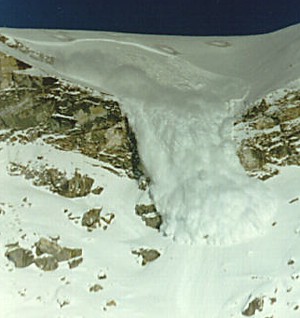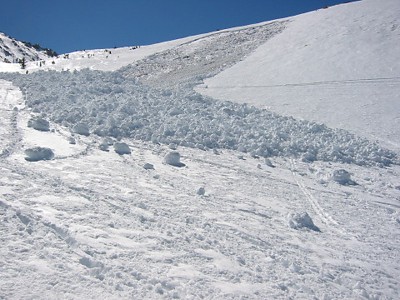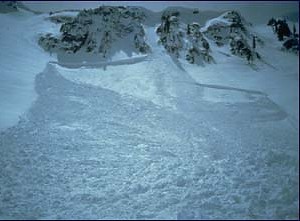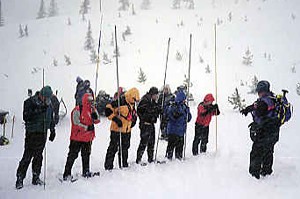For your own safety, take an Avalanche Safety Course.

The majority of avalanches are "dry slab" avalanches, and start on 30-40 degree convex slopes above or near the tree-line, on lee or cross-loaded slopes
Avalanche. A glued plate of snow that travels at 60-80 miles per hour like a pane of broken glass sliding off a tilted table.
Avalanche. The only natural hazard usually triggered by the victim.
Avalanche. Thirty minutes after being buried, the chances of survival are 50%. Avalanche. Buried two hours, the victim is dead.
Avalanche. Tons of snow in a short amount of time, wind blow and deadly. The kind of snow conditions surrounding most of the Sierra Nevada backcountry after periods of heavy snow.
Loud noises don't trigger avalanches, people do. In most cases, the victim-a snowmobiler, skier, snowboarder or recreationist triggers the avalanche, and dies within it. In 90% of all avalanche accidents the avalanche is triggered by the victim, or someone in the victim's party.
Avalanches don't strike without warning, they happen at particular times, and they are created by weather and snow conditions. Avalanches aren't predictable, but the weather conditions that produce them can foretell of the upcoming danger.
In the Sierra Nevada, avalanches occur where there are large deposits of snow. They can also occur in a thin snowpack, where the snowpack is the most variable, and has great potential damage, according to SP Parker, of Sierra Mountain Center in Bishop. Most slides that bury people, Parker said, occur within the top three feet of the snowpack.
Read the details here.

Avalanche in Elderberry Cyn on Mt. Tom, March 11, 2004
Steve Burnham Photo
Judging the avalanche dangers is not the work of amateurs. The region around Mammoth Lakes receives enough snow at times to make a call or search of the Eastern Sierra Avalanche Center website for snow conditions more than worth the time involved.
In fact, a call could make the difference between a fun time and a funeral.
Avalanches don't just happen during and after snow storms either. This depends upon the region, and in the Sierra 90% occur during the storm cycle, or within 24-hours after the storm.
Parker explained, "in different climates such as Colorado, the conditions can persist for days.
Come March we start to get into a cycle of wet slides, rather than dry ones. These are actually easier to predict."
According to experts, the most dangerous time for avalanches is March when weather is warmer and the increased sunshine creates snow conditions that can change quickly in a 24-hour period.
The Death Spiral

More people died in 2002-2003 in avalanches than any other period in U.S. history. By the end of the year, 36 men, women and children lost their lives in avalanches, and the 2003-2004 winter has started on an ominous note, with three snowboarder deaths in Provo, Utah.
Snowmobilers are the top avalanche victims. Equipped with their speedy rides and powerful sleds, snowmobilers can cover a lot of ground in a day, and they also encounter the best chances of slanting into danger. But snowmobilers aren't the only ones loosing their lives in record numbers.
Backcountry enthusiasts are creating a trend in this country, and as more and more people develop their skills to get into the remote regions, more and more of them die in avalanches. Unfortunately, avalanche skills haven't kept up with backcountry access.
Despite warnings to stay out of the backcountry, thousands of snow trekkers make their way to treacherous snow packs. There aren't any firm figures on the numbers of recreationists venturing into avalanche territory each winter, but the sales of gear indicate that the numbers are increasing rapidly.
Avalanches aren't prejudice. Both the experienced and novice backcountry lovers are victims, although research says the average avalanche casualty is a male between 20 to 29 years of age. Large numbers of people caught in avalanches are quite experienced guides, but data indicates that less than 1% of all avalanche fatalities involved avalanche professionals.

Commercial guided tours into the backcountry in the U.S. are NOT required to have certified mountain guides (individuals who have gone through training courses designed to understand and recognize avalanche risks), and a thorough check of the guide's level of avalanche knowledge could be a lifesaver.
An avalanche course (an average of about $250 for three days) could be the best preparation for a day in the backcountry, and the knowledge gained could help an individual assess avalanche risks for themselves.
Experts say preparations for the backcountry should go through three phases: first, learn what causes avalanches and be able to recognize the risks. Second, have access to and be able to understand, avalanche bulletins, weather forecasts and satellite imagery. Third, every person in the group should be equipped with a shovel, a probe and a beacon.
Beacon search training
The Slab That Kills
Most avalanches are "hard slab" avalanches, or cohesive plates of snow that shatter like a pane of glass and slide as a unit down the mountainside. Outrunning an avalanche is nearly impossible, considering it travels at around 80 miles per hour, and even a fast snowmobile stands a slim chance of getting out in time.
Hard slab avalanches happen when the weak layer beneath the slab fractures or the bond between the two fails, commonly due to the additional weight of a person, and this overloads the buried weak layer. Snow is sensitive to the rate at which it is loaded or stressed, and too much snow in a short amount of time (i.e. two feet of snow in two days or two hours) combined with wind, creates a huge problem.
Research says wind is a common cause of avalanches, blowing the snow around to form a slab. The other type is loose snow. A strong wind can deposit snow 10 times faster than snow falling from storms, and wind erodes snow from the upwind side of obstacles and deposits snow on the lee sides (downwind). This is called "wind loading." The weight of new snow also causes avalanches, as does rain or the melting of snow.
It Only Takes Seconds
Avalanches only take seconds to happen, leaving virtually no time for thinking. A dry slab avalanche reaches 60-80 miles per hour in five seconds, and once the victim is caught in the dense snow, only seconds are available for escape. Actions to save oneself, such as grabbing a tree, swimming or preparing to be buried must be done before the avalanche settles. Once the wall of snow stops sliding, it sets up like concrete or a body cast, making movement almost impossible. Although there is air in the snow, death from suffocation accounts for about 80% of the fatalities. Trauma, like hitting rocks and trees in the avalanche, only account for a quarter of the deaths involved in an avalanche.
People die in avalanches when their carbon dioxide builds up in the snow around their mouth. "What happens here is that the warmth of the respiration causes a thin film of ice to coat the snow, and this cuts off the flow of air to the victim," Parker added. They then quickly die from carbon dioxide poisoning. Research shows that 93% of avalanche victims can be recovered alive if they are dug out within the first five minutes, but then the numbers drop drastically. According to avalanche statistics, after 45 minutes, only 20-30% are still alive, and after two hours almost no one is alive.
In other words, there isn't any time to waste. Hopefully, someone in the party has watched the victim in the avalanche travel downhill, and they can help the group start digging with more accuracy. A partner or members of the party must dig for the avalanche victim, there is no time to call 911 or seek emergency assistance. Members must have the knowledge of where to look, the equipment to probe for the victim, and dig them out in time. Remember, 30-minutes after they're buried, the chances of their survival drop to 50%!

Search training with probes
Look for clues, like hands sticking out of the snow, snowmobiles, skis, gloves, and in most snowmobile involved avalanches, the victim is uphill from the snowmobile. "The last seen point is important. They will be downhill of there," Parker stated.
If there isn't a beacon attached and no probes available, use a ski pole or a broken tree branch and randomly probe as quickly as possible. In multiple burials, look for the shallow burials first and get them breathing.
Looking at the weather reports, avalanche warnings and snow conditions only takes a few seconds. If a person has the time to think about going into the backcountry, on skis, snowmobile or snowboard, they have the time to become educated about the terrain in winter, and its hazards.
The Sierra Mountain Center, and other local agencies provide avalanche safety courses (Level I-III) during the winter months, and Parker stated that an avalanche course at about $250 for three days is well worth the investment. Ultimately, the course could save lives by helping snow enthusiasts assess avalanche risks before they happen.